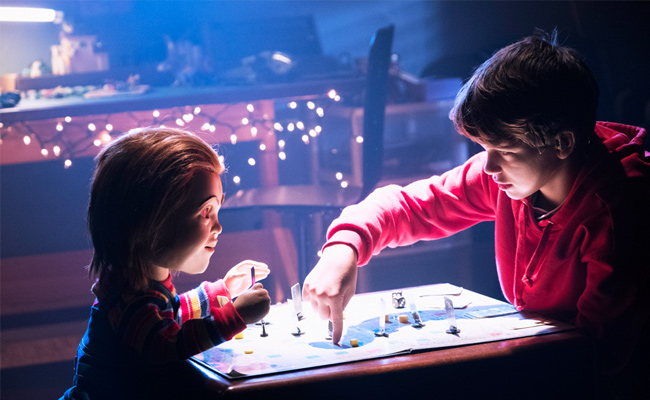
To its credit, MGM’s new Child’s Play reboot manages to justify its relevance to 2019 in about 10 seconds. It opens with a Robocop-style† direct address commercial starring Tim Matheson for the Buddi Doll, from the Kaslan Corporation (reminiscent of Robocop’s Omni consumer products). Buddi is essentially an anthropomorphized Alexa, who can not only control all your internet-connected Kaslan products but also give small hugs and sing songs about friendship. The doll, largely constructed out of practical effects with computer animated facial expressions, is also nicely creepy.
Connect a scary doll to the internet and suddenly there are all sorts of contemporary satire opportunities. If “why does the doll kill?” is the big question, “because he was connected to the internet” is an answer most people in 2019 could easily believe. The news is full of spree killers and extremists whose madness has almost certainly been exacerbated by algorithms that prioritize extreme content and tailored news items that fan their previously-held prejudices. It’s not a big leap from Roman sword-wielding martyrs of the incel-net to killer Alexas.
Yet after so promisingly setting itself up for contemporary relevance (no easy feat!), Child’s Play clearly, definitively decides to exist not in contemporary society but in schlocky movie world. You can trace it back to a single scene.
Early on, we discover that a disgruntled Vietnamese toy designer has, as a last F-you to his employer, disabled all the safety protocols on his last Buddi doll (including setting the “violence inhibitor” to “off,” which is pretty funny). The doll eventually finds its way to the unnamed American city where most of Child’s Play is set (blighted, urban, vaguely East Coast-y), where it’s returned as defective to the Marshalls-esque discount store where Karen, played by Aubrey Plaza, works.
Overworked single mom Karen gifts it to her preteen son, Andy (Gabriel Bateman), to whom defective Buddi becomes Andy’s first friend in their new town, despite his glitches (when Andy names him “Han Solo,” Buddi hears “Chucky,” among other things). When the other kids in Andy’s apartment complex realize Andy’s Buddi doll can use swear words and do other usually-prohibited things, Andy starts making real friends. While Child’s Play, directed by Lars Klevberg and written by Tyler Burton Smith, is usually pretty spot-on in its depiction of what entertains shithead 13-year-olds, one of their first acts together is watching The Texas Chainsaw Massacre on TV as a group. This is the scene in question.
Really? With all the narrative possibilities of 2019, Chucky gets radicalized by an old VHS tape? Given the choice between being relevant and reminding you of other movies, Child’s Play clearly chooses the latter. This happens with lots of movies, but rarely does the fork in the road between innovation and imitation manifest so starkly. Even new Chucky’s glitches — staticky, bookended by classic broadcast TV fuzz — are analog and anachronistic. Is the contemporary world really so boring that we have to retreat into tropes here, to the point of setting this in some VHS steampunk alt-reality?
It’s a shame, because Child’s Play does have a lot going for it, like a solid sense of humor, brashness, and an interesting cast (future Oscar-winner Brian Tyree Henry plays Karen and Andy’s down-the-hall cop neighbor). The uninhibited gore is nice at first, but as the movie progresses it starts to feel like flailing. It doesn’t know what it’s about, but at least it’ll be bloody! People love blood, right?
Also, about that: the movie wants to be hard-R gory (fine, good) but it’s told largely through the perspective of children, who have to be played by child actors (never good). Which raises the question, who this is for? The extreme blood-and-guts lovers or younger kids who don’t mind mediocre teen acting? Tonally it’s like Stranger Things meets Saw.
But “who is this for” is a question you only start asking when you’re no longer telling the story for yourself, and Child’s Play‘s creators seems to lose the plot about halfway through. There are times the execution can’t live up to the conception. As in a scene with a lawnmower and some Christmas lights, where we can guess what’s happening just based on the elements involved and the genre, but Klevberg never really communicates it visually. In a lot of ways, Child’s Play seems like a good idea that the people involved didn’t have either the time or the talent to execute properly.
Movies that ultimately blow it in the way Child’s Play does don’t just make me sad for the movie — which isn’t even that bad, it’s mostly just fine — it makes me wonder about the health of the entire format. There’s that clear moment where Child’s Play has the choice to comment on the world and instead choose to comment only on other movies. Is that where we’re headed? As fewer people actually go to the movies, are movies becoming a product by and for this self-selecting, limited audience of purists, where creators strive not for contemporary relevance but for a nostalgia play that exists simply to remind movie-lovers of the world of movies past?
I hope not, but movies like this make me wonder.
‘Child’s Play’ opens this weekend in theaters nationwide. Vince Mancini is on Twitter. You can access his archive of reviews here.
†There are a couple Robocop references in Child’s Play, which are only really relevant if you know that MGM owns both franchises and, as of last year, had plans for another reboot of Robocop.






